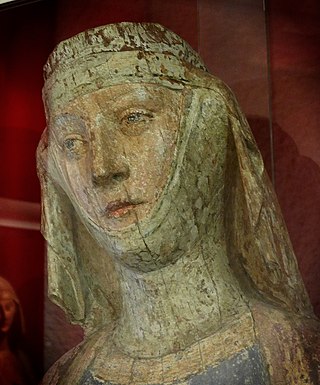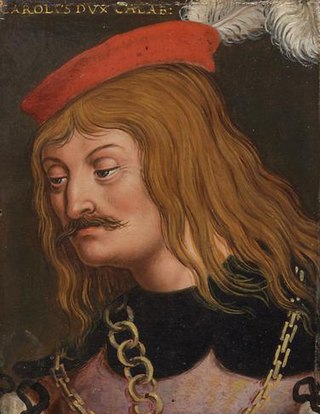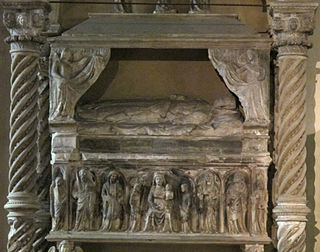
Robert of Anjou, known as Robert the Wise, was King of Naples, titular King of Jerusalem and Count of Provence and Forcalquier from 1309 to 1343, the central figure of Italian politics of his time. He was the third son of King Charles II of Naples and Mary of Hungary, and during his father's lifetime he was styled Duke of Calabria (1296–1309).

Joanna I, also known as Johanna I, was Queen of Naples, and Countess of Provence and Forcalquier from 1343 to 1382; she was also Princess of Achaea from 1373 to 1381.
Charles of Durazzo, also called Charles the Small, was King of Naples and the titular King of Jerusalem from 1382 to 1386 as Charles III, and King of Hungary from 1385 to 1386 as Charles II. In 1381, Charles created the chivalric Order of the Ship. In 1383, he succeeded to the Principality of Achaea on the death of James of Baux.

Francis I of the Two Sicilies was King of the Two Sicilies from 1825 to 1830 and regent of the Kingdom of Sicily from 1806 to 1814.

Ladislaus the Magnanimous was King of Naples from 1386 until his death and an unsuccessful claimant to the kingdoms of Hungary and Croatia. Ladislaus was a skilled political and military leader, protector and controller of Pope Innocent VII; however, he earned a bad reputation concerning his personal life. He profited from disorder throughout Italy to greatly expand his kingdom and his power, appropriating much of the Papal States to his own use. He was the last male of the Capetian House of Anjou.

Joanna II was reigning Queen of Naples from 1414 to her death, when the Capetian House of Anjou became extinct. As a mere formality, she used the title of Queen of Jerusalem, Sicily, and Hungary.

Philip II of the Angevin house, was Prince of Achaea and Taranto, and titular Latin Emperor of Constantinople from 1364 to his death in 1373.
Andrew, Duke of Calabria was the first husband of Joanna I of Naples, and a son of Charles I of Hungary and brother of Louis I of Hungary.

Catherine II, also Catherine of Valois or Catherine of Taranto, was the recognised Latin Empress of Constantinople from 1307–1346, although she lived in exile and only had authority over Crusader States in Greece. She was Princess consort of Achaea and Taranto, and also regent of Achaea from 1332–1341, and Governor of Cephalonia from 1341–1346.

Charles, Duke of Calabria, was the Duke of Calabria from 1309 until his death. Upon his father's elevation as King of Naples, he was made vicar-general of Naples and duke of Calabria He was elected as signore by the city of Florence in 1326. Charles died on 9 November 1328 in Naples.

Charles of Durazzo was a Neapolitan nobleman, the eldest son of John, Duke of Durazzo and Agnes of Périgord.

Duke of Calabria was the traditional title of the heir apparent of the Kingdom of Naples after the accession of Robert of Naples. It was also adopted by the heads of certain Houses that had once claimed the Kingdom of Naples in lieu of the royal title.
Margaret of Durazzo was Queen of Naples and Hungary and Princess of Achaea as the spouse of Charles III of Naples. She was regent of Naples from 1386 until 1393 during the minority of her son Ladislaus of Naples.

The Capetian House of Anjou, or House of Anjou-Sicily, or House of Anjou-Naples was a royal house and cadet branch of the Capetian dynasty. It is one of three separate royal houses referred to as Angevin, meaning "from Anjou" in France. Founded by Charles I of Anjou, the youngest son of Louis VIII of France, the Capetian king first ruled the Kingdom of Sicily during the 13th century. The War of the Sicilian Vespers later forced him out of the island of Sicily, which left him with the southern half of the Italian Peninsula, the Kingdom of Naples. The house and its various branches would go on to influence much of the history of Southern and Central Europe during the Middle Ages until it became extinct in 1435.

Maria of Calabria, Countess of Alba, was a Neapolitan princess of the Capetian House of Anjou whose descendants inherited the crown of Naples following the death of her older sister, Queen Joanna I.

Marie of Valois, was the eldest daughter of Charles of Valois by his third wife Mahaut of Châtillon. She was a member of the House of Valois. One of her five children was Queen Joanna I of Naples.
Joanna of Durazzo was the eldest daughter and eldest surviving child of Charles, Duke of Durazzo, and his wife, Maria of Calabria. She succeeded as duchess on the death of her father in 1348 when she was only a child of four years old. Joanna was a member of the House of Anjou-Durazzo.
Agnes of Périgord was Duchess consort of Durazzo, through her marriage to John of Gravina, Duke of Durazzo, who was also the ruler of the Kingdom of Albania. Although Agnes was never styled as Queen consort, she became politically influential. Following the death of Robert, King of Naples in 1343, she organised a marriage for her eldest son to Robert's granddaughter, who was second-in-line to the Neapolitan throne. Agnes's ambition was to bring her family closer to the line of succession.